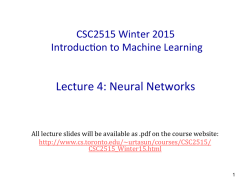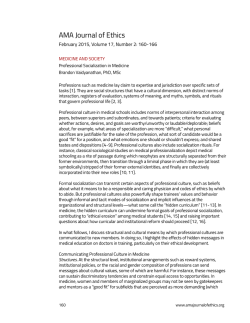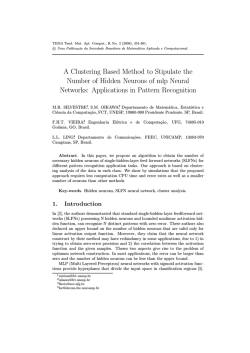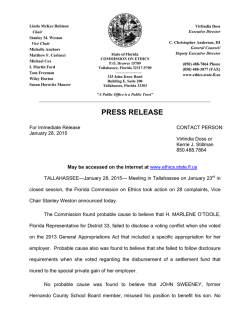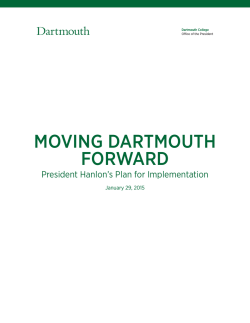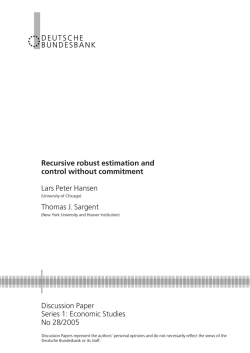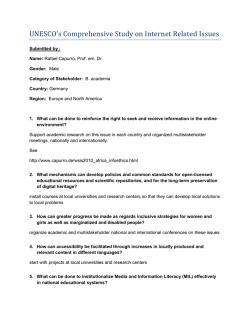
AMA Journal of Ethics - American Medical Association
AMA Journal of Ethics February 2015, Volume 17, Number 2: 129-137 MEDICAL EDUCATION The Role of the Hidden Curriculum in “On Doctoring” Courses Frederic W. Hafferty, PhD, Elizabeth H. Gaufberg, MD, MPH, and Joseph F. O’Donnell, MD In this paper, we briefly examine the role of the hidden curriculum (HC) in a particular type of medical education format: the “on doctoring” (OD) course. Background: The Structure and Function of “On Doctoring” Courses Although no description currently exists in the medical education literature on the emergence, content, and purposes of OD courses, this somewhat new addition to the formal compendium of undergraduate medical education does have a considerable Internet presence. Searches for “on doctoring” courses (along with associated terms such as “art of medicine,” “art of doctoring,” and “physicianship”) reveal that a number of medical schools have adopted such an educational vehicle. While the content and length of OD courses can vary by school, the following description from the Geisel (Dartmouth) Medical School is not atypical in form or content. On Doctoring is a two-year course that provides an understanding of the role of the physician in the clinical setting and in the community through longitudinal clinical and small group learning experiences in the first two years of medical school. During the first year, the course will focus on patient interviewing, physical diagnosis, physical exam, patient write-ups from student’s [sic] clinical encounters, clinical reasoning, and developing the doctor-patient relationship. The second year builds on these skills with additional course work and a higher level of learning [1]. In addition to this formal description, Geisel details several course objectives (e.g., patient interviewing, physical diagnosis, oral presentations and clinical write-ups, doctor-patient relationship), along with a list of course requirements/expectations (e.g., “Taken a focused history of a standardized patient that is recorded and observed by the facilitator”) that need to be met before students can move into the second year [1]. For comparison, Alpert Medical School at Brown University formally describes its OD course as follows: Doctoring is a two-year required course intended to teach the knowledge, skills, attitudes, and behaviors of the competent, ethical, and humane physician [2]. AMA Journal of Ethics, February 2015 129 The widespread presence of OD courses today stands in some contrast to the more “traditional” ways that doctoring has been taught in US medical education. In the “old days,” training was mostly informal and ad hoc, although students often received a brief bridging course near the transition to their clinical years. Often, these were called “physical diagnosis” courses, with the name reflecting the content being emphasized. Conversely, subjects such as interviewing and communication skills, write-ups, presentations, patient expectations, and other important elements of clinical practice received relatively little attention. Sometimes, individual clerkships would include an introduction to the service, but the bulk of student learning occurred “on the go.” In sum, learning was predominantly experiential, idiosyncratic, context-dependent, and serendipitous. You saw what you saw, you learned from these experiences, and most importantly you learned that there was not just “one right way” to do things. Today, most medical schools provide their students with considerably more formal instruction on a range of clinically relevant topics including professionalism and how to take a history, conduct difficult conversations, and do a physical exam. The intent behind this shift is described by one medical student in an OD blog: In the past, this kind of “non-textbook” knowledge was never formally taught—you learned, on the go, on the floors of the hospital. Nowadays, with a renewed emphasis on patient centered care, medical schools are trying to better prepare students before they encounter real patients [3]. The issue, however, is not just about something being formally taught in one setting versus experienced in another. Consider the following string of quotes, taken from an online forum on “on doctoring,” which can be contrasted with both the above blog description and the OD objectives specified by Geisel and Brown. Here, the picture is less flattering to OD, with students taking away a variety of other-than-positive messages about their experiences. The quotes are excerpted from a longer list of responses to the question “Does your school have a ‘doctoring’ course?” Some comments focus on the idea that OD material is obvious and hardly needs to be taught. It’s fun learning to interview for the first time, but after a while, doing all the various topics is pretty much a waste of time. It’s mostly just obvious stuff (don’t hit on the teenage girl even if she comes on to you, don’t refer to people by racial epithets). Being able to apply the stuff when you volunteer at clinics is fun though [4]. Other comments stress the inauthenticity of the learning experience. yes. i thought it was going to be my favv course but I was mistaken! interviewing “actors” in front of big groups while being thrown into scenarios where there are always hidden agendas that you need to uncover is a bit excessive [4]. 130 www.amajournalofethics.org Some students contrasted OD courses with the academic demands of the overall curriculum and how those broader, “more basic,” or “more important” demands trump the intended lessons of OD… I enjoy it too, but I think we devote entirely too much time to it (2+ hours weekly) and it takes away from academics because on “doctoring” days we don’t have science lectures [4]. Our school has “doctoring” every Friday...which means we basically have a 3 day weekend every single weekend. It’s awesome for morale, but terrible for academics [4]. …along with the description of a “helpful” (if unwitting) faculty member who inadvertently kept reminding students that they were wasting their time. The professor begins every other sentence with “I know this is common sense but...” [4]. Although it might seem odd that doctors-to-be would so roundly criticize a course that supposedly is teaching them clinical skills, it is important to recognize as we move into a discussion of the hidden curriculum that these student reactions, rather than being idiosyncratic or ad hoc, reflect a basic set of messages students receive from the milieu of their school, i.e., that the “real” task at hand is to pass their basic science coursework and that the important clinical exposures will come later in their training. In this respect, students are picking up a variety of “lessons” about what is and is not important to their status as student learners and future doctors—messages that will not be found in any course outline, list of course objectives, student handbook, or medical school mission statement. In addition to formal or intended curriculum delivered by faculty, all medical schools contain a range of more tacit and subterrestrial types of lessons, lessons that often are subsumed under the label “hidden curriculum.” The Hidden Curriculum The hidden curriculum can be broadly defined as the attitudes and values conveyed, most often in an implicit and tacit fashion, sometimes unintentionally, via the educational structures, practices, and culture of an educational institution. Within this definitional framework, studying medical education means, above, all, embracing the importance of context. All relationships, from the dyad to entire societies, take place within an array of environmental factors that can influence, sometimes profoundly, what is happening within the particular situation we seek to understand. One of the most foundational axioms of an HC-awareness perspective is that teaching is not the same thing as learning. While this point seems quite commonsensical today, it was not as universally accepted when discussions about the HC begin to infiltrate medical education circles in the early 1990s [5]. Prior to this time, there was a widespread belief that medical education could be adequately understood by focusing on what a school officially said it did, including courses taught and clinical experiences offered—in HC parlance, the “formal curriculum.” For example, for most of the twentieth century, AMA Journal of Ethics, February 2015 131 accreditation decisions made by the Liaison Committee on Medical Education (LCME) focused almost exclusively on what schools formally stated they were doing—things like course content, hours and requirements, along with student evaluations of those formal offerings. How well students might be learning, including factors that might accelerate or retard that learning, were not part of the evaluation equation. In effect, the LCME accreditation process tacitly told schools that “seat time” was more important than what trainees were learning or the actual competence of their graduates. Having enough hours of anatomy or seeing the requisite number and type of patient were the operative metrics de jour. Alternative framings such as “competencies” (e.g., behavioral outcomes of educational practices) were not part (as they are now) of the educational lexicon [6]. A second principle, closely tied to that of context, is that the more complex the organizational setting the more likely there will be disjunctures between official statements about what is happening (“This is how we do medical education.” “This is how we do patient care.”) and what actually takes place on the clinical shop floor. Medical schools are extremely complex organizations inhabited by many social actors (e.g., faculty, students, administration, staff, patients, other health care workers), all engaged in complex sets of interactions around both the learning of medicine (the goal of education) and the care of patients (the goal of doctoring). In short, medical schools are multidimensional, relational, dynamic, and complex and thus loaded both with tensions and the potential for contradictions. For both of these reasons, it is helpful to think of the HC as an alternative way of looking at things—alternative to the official or the formal account of what is going on. This often is an underappreciated point. The HC is not always negative or bad, something to be overcome. Nonetheless, there often is more taking place than official accounts will encompass. Thus, whenever one hears the official version of things, the next question should be: “What else is going on?” or “What else might be lurking just beneath the surface?”—and there almost always is something taking place other than what official accounts might acknowledge. Although singular, the term “HC” should be thought of as a category label that encompasses a range of other-than-formal curricula—including curricula that are informal, hidden, and “null.” As a form of social action, medical schools (like other educational settings) are awash with curricula, often with multiple lesson streams coursing through the learning environment at any given point in time. As such, it would be analytically misleading to think of a medical school as having a (singular) hidden curriculum or an informal curriculum, or a singular anything else. Some of these curricula can be defined as follows: 1. formal curricula: what a school formally states—its mission statement, course curricula, materials, and objectives 2. informal curricula: unscripted and predominantly ad hoc teaching and learning that occur outside of the formal curriculum (e.g., during ward rounds at the bedside) and that contain messages that can be consistent or inconsistent with the formal curriculum 3. hidden curricula: lessons, especially about norms and values, that are embedded in a school’s organizational structure and culture but not explicitly intended to be 132 www.amajournalofethics.org 4. taught, which may be supportive of or contrary to the formal curriculum null curricula: that which is taught through omission—for example, when something that is not mentioned in class or role modeled on the wards becomes something students conclude must not be important [7]. Given these core distinctions, care must be taken not to use the terms “informal” and “hidden” as interchangeable. Although there can be some overlap, it is important to stress that “hidden” means hidden. A great deal of what takes place in organizational settings may be tacit, but nonetheless still commonly understood—and shared. Workarounds are a wonderful example of informal teachings [8]: “the book/rules say this is how you transport a patient or do a procedure, but everyone knows (around here) that the best way to transport or carry out the procedure is this other way.” There is nothing hidden here. Everyone is quite aware both of the formal and the “other” way. There is, however, another kind of learning that often does fly beneath the radar—and thus functions in a more invisible or unconscious manner. Much of what unfolds within this domain of learning has to do with culture, particularly organizational culture. When the routines of daily activity unfold in their typically routine and predictable ways, the values they convey are often invisible because they are taken for granted. They remain assumed and unnoticed until something unexpected happens, something outside the norm/rule/usual, or until these routines are looked at by someone new to them. And, all of a sudden, the invisible becomes visible. Within this context, it is helpful to think of trainees, particularly new trainees, as hypersensitive readers of the new environments they encounter. They are strangers in a strange land, and thus desperately engaged in trying to “make sense of things.” As such, neophyte students are able to notice the wrinkles and nuances that actually make up most communities and group activities. However, as trainees move deeper into the culture of the group they seek to join (in this case the culture both of their medical school and the medical profession as a whole), they accept and become desensitized to the nuances and inconsistencies that once grabbed their attention. They “see less” as more and more of their surroundings become taken for granted. They become more like those core insiders for whom “what is” is “what it should be.” Analyzing the Hidden Curriculum In and Around “On Doctoring” Courses As we have seen, many elements within and surrounding OD courses convey messages, and there are several challenges in making sure those messages do not undermine the intended learning outcomes. The first challenge is to adequately structure the course material. The array of topics, formats, and issues typically included under the OD banner need to be painstakingly integrated in a way that conveys intention. Not to do so sends an HC message to students that OD is a dumping ground for unimportant or otherwise orphan material. However sympathetic or personally open to OD content students may be, a carelessly organized or incoherent course will “teach” them that the real, important educational action is happening somewhere else. A second challenge has to do with the relationship between OD and other courses. OD never takes place in an educational vacuum. Other courses exist and other educational AMA Journal of Ethics, February 2015 133 experiences always vie for students’ attention and time. Operating from an HC perspective demands that we be aware of these other players and account for their presence in evaluating the import and impact of a school’s OD effort. Most obviously, we must be sensitive to how courses are scheduled. Does OD have a “prime-time” place, and therefore status, or does it take place when and where it will not interfere with “more important” coursework? Students are quite adept at reading these messages. Students receive one set of signals when a school extends its OD course across all four years of training and another when it restricts this offering to the “preclinical” curriculum. The absence of a safe and regular opportunity to reflect on clinical and ethical challenges, role-play communication strategies, and work out professional boundary issues that arise in clinical settings not only creates a learning void, but also can function as a null curriculum, with such an absence telling students that the issues they are wrestling with are not terribly important, should already have been mastered, or are things they are expected to resolve “on their own.” Other courses, teachers, and material may also directly contradict OD courses’ lessons. What students are being formally taught is “the right way” in class or simulation lab may not be what they encounter when they actually find themselves in clinical settings. For example, in an OD critiquing session, at one school, a student (also quoted below) mentioned that she hardly ever saw her preceptors doing some of the things the course was teaching her, like responding to emotions. In addition, many of her classmates felt the things being taught were too “touchy-feely, and…everyone seemed less interested in the interviewing and more anxious to do the physical exam right.” A third and particularly important challenge is that of selecting teaching methods that reinforce, rather than undermine, the messages, values, and skills intended to be conveyed. Consider these real-life examples from two different OD courses: A first-year student was interviewing a standardized patient. She was methodically going down her checklist both in her mind and on the paper on her clipboard in her hand, trying desperately to keep her periods of eye contact up, asking enough open-ended questions, and remember all the mnemonics she has been taught. She reached the time to ask the patient about the family history. When she asked the patient about her children, the patient hesitated a bit, her eyes lowered to look at the floor and teared up as she said: “I’m worried about my daughter.” Desperately trying to remember the mnemonics about how to respond to emotion or to show empathy, and thinking about the next set of questions on the script she had to get completed, the student nervously blurted out; “Do you have other children? And is there any diabetes or heart disease in the family?” (unpublished data). The use of checklists to help neophyte trainees navigate their way through an unfamiliar landscape of history and physical taking also can trap them into not recognizing a quite human and poignant moment. 134 www.amajournalofethics.org This second story comes from another school’s OD curriculum. A key part of this school’s OD offerings is a small-group experience in which students can confidentially talk about and reflect upon issues of concern. One of our older male attendings on the OB service would offer medical students the opportunity to perform pelvic exams on anesthetized patients who were about to undergo surgery. Two female students in particular took issue with this. They felt uncomfortable with the fact that the patients had not consented and that there was no advantage to the patients in having students “practice” their exam on them. Students felt it was an abuse of power with especially vulnerable patients. Students raised this concern with the OB-GYN in question who responded that patients agree to come to a teaching hospital and consent is implied under the general consent form. The exam was not hurting them and in fact they would not even know it had happened. He continued the practice. The students brought this concern to our patient-doctor group—and several chose to write their reflection paper about the issue. The male students, while sympathetic to the concerns, raised the fact that often patients decline to allow them to examine the patient, and thus worried they were not getting enough experience. We spent a lot of time reflecting on the issue in our group, weighing the ethical principles involved, examining med school/hospital policies (ours and others), deciding whether to report the practice to our hospital ethics board. Finally the group made a collective decision that it would be permissible to do pelvic exams under anesthesia on patients [with] whom students had formed an initial relationship during a pre-op visit and specifically had asked if the student could be present and examine them while they were under anesthesia. Then, the students role-played the best way to obtain consent. They informed the OB that this is how they had decided to proceed as a group. The group leader was very moved by the way they used this forum of their peers to problem solve, practice communication skills and come to a group decision (unpublished data). Here, students raise an issue of concern within a safe environment and work with their OD small group faculty to come to a collective resolution. This is in contrast to the all-tootypical medical educational environment, in which hierarchy reigns and students live in great fear (and reasonably so) of offending the faculty who will grade them and assess their competencies and professionalism—all potential fodder for a dean’s letter that may determine residency placement. Parenthetically, and ever-vigilant to possible HC messages, it is important to note that when a school offers a structured opportunity labeled “safe harbor,” that school may inadvertently imply that places outside the harbor are “unsafe”—which is quite a thing for a school to claim. Returning to the above example, instead of merely asking students to memorize and repeat a “right way” of addressing problems, this structure encourages them to come up with their own answers and to collaborate with each other. OD becomes most transformational when students realize that ultimately they have access to each other and like-minded faculty as supporters not only inside but outside the group, and that change AMA Journal of Ethics, February 2015 135 need not wait until formal class time. When optimally designed and delivered, OD functions as an important learning vehicle for what it means to be a physician in a rapidly changing health care world. Students embrace such opportunities. Directors of OD courses that do not offer students this feature might wish to consider adding it. Finally, and lest we forget, attention to how material is presented in terms of voice is a continuing challenge. It is important that OD faculty not emulate the unwitting instructor (quoted earlier in the paper) who began every other sentence with “I know this is common sense but...” [4]. Nonetheless, and although some HC problems may be solved by the presence of faculty who are non-defensive and unapologetic in the face of challenges, the more fundamental challenge comes from the overall cultural context of medical training in which OD courses take place. The fact that we can find many students appearing to be dismissive and/or disparaging of OD would require us, from an HC perspective, to at least investigate further to understand the broader context of what else might be going on. Conclusion From an HC perspective, the greatest threat to OD courses is the current gulf that may exist between the “on doctoring ideals” being taught within such courses and the “reality” that students encounter when they circulate to other courses and “actual” clinical settings. Pro-OD rhetoric and aspirations aside, it always will be easier to design an isolated OD course awash with the “right stuff” and the “right ways” than it is to change the underlying culture of the medical school or the array of cultural practices that make up the broader clinical environment. For this reason, students most likely will continue to struggle to “make sense” of why they are learning one thing “here” and other things “there.” Until organizational cultures and practice environments change (and they are changing) to better reflect pedagogical aspirations and the ideals of clinical practice (e.g., safe, patientcentered, high-quality), students will continue to receive conflicting messages about what it really means to be a “good doctor.” Within this context, OD becomes most transformational when students realize they have access to each other and like-minded faculty as supporters not only inside but outside the group, and that change need not wait until formal “class time.” When students start creating these safe havens on rounds and within related clinical activities via the creation of supportive dyads and small groups, the culture of medical practice does begin to change. References 1. Dartmouth University Geisel School of Medicine. MDED 116: On Doctoring - year 1. https://geiselmed.dartmouth.edu/ed_programs/courses/courses_yr1_newd116. shtml. Accessed December 30, 2014. 2. Brown Alpert Medical School. Doctoring: the prescription for curriculum innovation. https://brown.edu/academics/medical/sites/brown.edu.academics.medica l/files/uploads/Doctoring_Brochure.pdf. Accessed December 30, 2014. 3. Chiu S. On doctoring. Merck Manuals Student Stories. http://medstudentstories.merckmanuals.com/on-doctoring/. Accessed December 136 www.amajournalofethics.org 30, 2014. 4. Student Doctor Network. Medical student forums: does your school have a “doctoring” course? http://forums.studentdoctor.net/threads/does-your-schoolhave-a-doctoring-course.1051897/. Accessed December 30, 2014. 5. Hafferty FW, Franks R. The hidden curriculum, ethics teaching, and the structure of medical education. Acad Med. 1994;69(11):861-871. 6. Hodges BD. A tea-steeping or I-Doc model for medical education? Acad Med. 2010;85(9)(suppl):S34-S44. 7. Hafferty FW, O’Donnell JF, eds. The Hidden Curriculum in Health Professions Education. Lebanon, NH: Dartmouth College Press; 2014. 8. Halbesleben JR, Wakefield DS, Wakefield BJ. Work-arounds in health care settings: literature review and research agenda. Health Care Manage Rev. 2008;33(1):2-12. Further Reading Cruess RL, Cruess SR, Boudreau JD, Snell L, Steinert Y. Reframing medical education to support professional identity formation. Acad Med. 2014;89(11):1446-1451. Frederic W. Hafferty, PhD, is a professor of medical education and the associate dean for professionalism in the College of Medicine and the associate director of the Program in Professionalism and Ethics at the Mayo Clinic in Rochester, Minnesota. Elizabeth H. Gaufberg, MD, MPH, is a double-boarded internist-psychiatrist, an associate professor of medicine and psychiatry at Harvard Medical School in Boston, and the Jean and Harvey Picker Director of the Arnold P. Gold Foundation Research Institute. Joseph F. O’Donnell, MD, is the senior scholar in the C. Everett Koop Institute, the Elizabeth Decamp McInerney Professor of Medicine, and the senior advising dean and the director of community programs at Dartmouth College’s Geisel School of Medicine in Hanover, New Hampshire. Together with Frederic W. Hafferty, he edited The Hidden Curriculum in Health Professional Education (Dartmouth College Press, 2014). Related in AMA Journal of Ethics Professional Socialization in Medicine, February 2015 Role Models’ Influence on Medical Students’ Professional Development, February 2015 The Role of Empathy in Medicine: A Medical Student’s Perspective, June 2007 The viewpoints expressed in this article are those of the author(s) and do not necessarily reflect the views and policies of the AMA. Copyright 2015 American Medical Association. All rights reserved. ISSN 2376-6980 AMA Journal of Ethics, February 2015 137
© Copyright 2025
